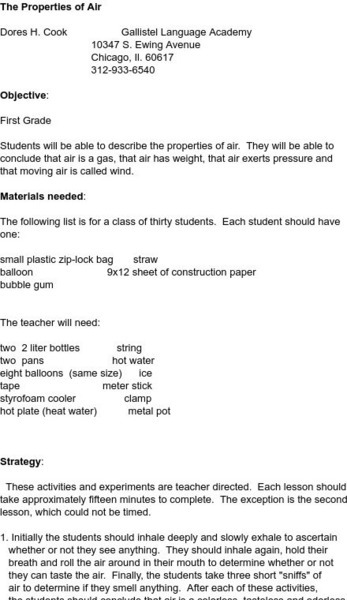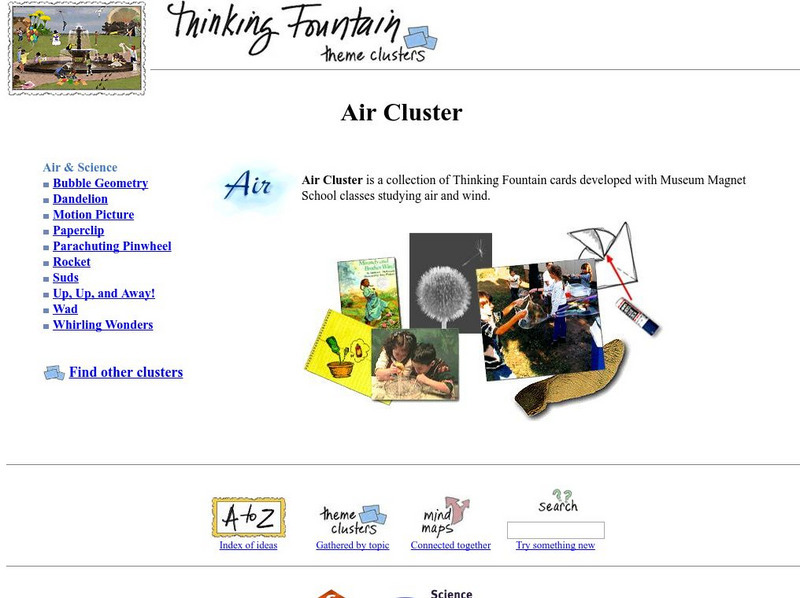Science and Mathematics Initiative for Learning Enhancement (SMILE)
Smile: The Properties of Air
Lesson plan to teach properties of air. Students use balloons, plastic bottles, plastic bags and a meter stick to conclude that air is a gas that has weight, exerts pressure, and moves.
PBS
Pbs Kids: Science Rocks: Air Lift
Through this experiment, students are challenged to lift a book (and other items) with just air. Requires simple household items, gallon-size, zipper-lock plastic bag, book, pencil, drinking straw, and tape.
NASA
Nasa: Gas Properties Definitions
Use this site to learn about basic gas properties including motion, viscosity, and compressibility. Includes links to activities for all ages.
Other
Educational Objects: Does Air Have Weight?
Explore the properties of air with this virtual experiment. Add air to a balloon to discover the property of weight.
Other
Federal Aviation Administration: Air Takes Up Room [Pdf]
See how air takes up space by conducting this classroom experiment. With the aid of several common objects, observe the effects of air pressure.
Other
Air Blaster: Smoke Ring Launcher
Steve Spangler shows how you can blow a cup off of your friends head and his or her papers off the desk with this "air blaster" or "AirZooka." Demonstrate that air does take up space and how air moves. What fun!
TeachEngineering
Teach Engineering: What's Air Got to Do With It?
Learners are introduced to the concepts of air pollution and air quality. The three lesson parts focus on the prerequisites for understanding air pollution. First, students use M&Ms to create a pie graph that expresses their...
Science Museum of Minnesota
Science Museum of Minnesota: Air Cluster
Interesting site with links to activities about wind and air in many forms. Browse the different activities and investigations on the properties of air on the toolbar to the left of the page.
American Chemical Society
Middle School Chemistry: Air, It's Really There
Explore the properties of air, and what happens to air when heated and cooled.
TeachEngineering
Teach Engineering: Air Pollution
Students are introduced to the concept of air quality by investigating the composition, properties, atmospheric layers and everyday importance of air. They explore the sources and effects of visible and invisible air pollution. By...
Globe
The Globe Program: Air Quality Module
In this storybook, the GLOBE Kids investigate colors in the sky and learn how air pollution affects sky color and our health. Learning activities engage students in describing sky color and conditions in the atmosphere, creating a model...
Science Education Resource Center at Carleton College
Serc: Density With Carbon Dioxide
A guided demonstration where middle schoolers investigate the properties of carbon dioxide gas and air based on density. Students learn about properties of air through observation and inquiry.
Science Education Resource Center at Carleton College
Serc: Air Is Matter
It's difficult at times for younger young scholars to realize that air has mass. Matter is something that has volume (takes up space) and has mass (*can be weighed). Air does take up space, even if we can't see it, and air has weight,...
Texas Instruments
Texas Instruments: Measuring Air Pressure
This activity is intended for an Introductory Meteorology class; an earth science elective intended for Juniors and Seniors. (It was orginally modifed from an Introductory Meteorology Laboratory Assigment taught to undergraduates at...
US Environmental Protection Agency
Epa: Air Toxics Website Manganese Compounds
Very thorough information on manganese. Lists its uses, where it is found, physical properties, and potential health effects.
US Environmental Protection Agency
Epa: Air Toxics Website Nickel
Very detailed information on the chemical element Nickel. Discusses its uses, physical properties, and the potential effects of exposure.
Museum of Science
Museum of Science and Industry: Activities: Fly a Hot Air Balloon
Step-by-step instructions, with photos, of how to construct a hot-air balloon from tissue paper, to demonstrate that heated air expands, creating a convection current. This activity requires the use of a hot air gun and is labor-intensive.
Other
60 Second Science: Air Putting It to Work
Investigate the properties of air. Observe the water vapor present in our exhaled breath.
Utah STEM Foundation
Utah Stem Action Center: What's Up With Our Air?
Students will use modeling to understand inversions. Their models will evolve as they gather more information.
University of Notre Dame
Und: Properties of a Pure Substance [Pdf]
Often we find that different phases of pure substances can exist in equilibrium with one another. Let us consider an important gedankenexperiment (Latin-German for "thought experiment") in which we boil water. Ordinary water boiling is...
Physics Aviary
Physics Aviary: Capacitor Properties Lab
This lab is designed to have students investigate the different changes that could be made to an air filled capacitor and the results that occur because of these changes. Students can vary the gap between the plates, the size of the...
PBS
Pbs Teachers: Hot Air Balloon Experiment
Explore how heat affects the density of air by building and flying a hot air balloon using large plastic bags and the hot air from an electric hairdryer.
TeachEngineering
Teach Engineering: Environmental Engineering
In this unit, students explore the various roles of environmental engineers, including: environmental cleanup, water quality, groundwater resources, surface water and groundwater flow, water contamination, waste disposal and air...
Annenberg Foundation
Annenberg Learner: Virtual Particle Lab: Compressibility of Air
Explore the particle model of matter. Run the simulations and see if you can predict the results.
Other popular searches
- Air Properties
- Science Properties of Air
- 4 Air Properties
- Properties of Air Powerpoint
- 5 Properties of Air
- Kindergarten Air Properties
- Air Properties Stations






![Federal Aviation Administration: Air Takes Up Room [Pdf] Activity Federal Aviation Administration: Air Takes Up Room [Pdf] Activity](https://d15y2dacu3jp90.cloudfront.net/images/attachment_defaults/resource/large/FPO-knovation.png)












